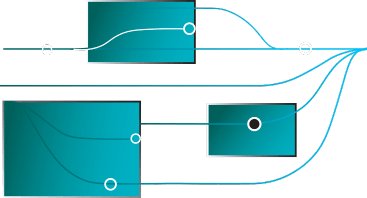How Mind Maps in Quality Engineering Can Help You Stay Ahead

As quality becomes a key priority, software development teams are using an array of Quality Engineering processes to speed up testing cycles. Yet, despite all the investments, they continue to face various challenges that impact quality, customer confidence, and business reputation. Mind maps are a great way to transform Quality Engineering outcomes.
What are Mind Maps?
If you had to explain the flow of an application to your QA team, how would you do it? You would probably prepare a detailed presentation to talk about the different elements. But would that help your team grasp the application flow? Would it help them recognize dependencies? Would it aid them in understanding testing requirements? Most likely not!
With devices getting increasingly fragmented, developing, deploying, and testing applications for omnichannel environments is becoming tough. Add to it the demand for high levels of security and the need for the software to recover from failure or breaches. The challenges of quality engineering stem from the inability to visually organize information into a hierarchy - showing relationships among pieces of the whole. This is where mind maps play a huge role.
Offering an easy way to brainstorm thoughts and ideas, mind maps allow quality engineering teams to form a visual structure to help with analysis and recall. They are generally created around a single concept, drawn as an image, and associated with representations of associated ideas and relationships. By transforming a complex hierarchy into a colorful, memorable, and highly organized diagram, mind maps act as a visual thinking tool. In essence, this tool helps better analyze, comprehend, synthesize, recall, and generate new ideas.

What Benefits Do They Offer?
Mind maps structure information in a way that resembles how the human brain works. As a result, they engage the brain in a much richer way and aid in organizing information, solving problems, and making decisions. Because mind maps help organize information in a visual, hierarchical way and showcase relationships among different elements, they help in:
- Visually structuring ideas and adding associated representations to a central concept while determining their role and significance
- Understanding the challenges/bottlenecks in the current design and crafting a better one for positive results
- Driving effective communication and brainstorming information to find better solutions faster
- Identifying missed scenarios and flaws and refining them for better efficiency and experience
Do more with Test Automation
Discover more ways to add ‘low-code no-code‘ test automation in your workflows

Why Do They Matter in Quality Engineering?
Quality engineers today have a complex web of features and capabilities to test across the software testing lifecycle. With so many different test cases to build and dependencies to track, capturing critical information or prioritizing test activities becomes difficult. However, mind maps offer a simple and easy way to:
- Capture critical information
- Understand dependencies
- Chart out a well thought test plan
Therefore, software developers or quality engineers can leverage mind maps to represent possible testing scenarios. They can identify a software feature's main sections/parts and divide them into main nodes. By creating branches, they can further represent how the functionalities should ideally behave.
In the realm of quality engineering, mind maps allow test engineers to visualize (and expand) expected testing paths, brainstorm critical testing requirements, and assess unexpected workflows. They also help create an outline for a testing activity and lay out test procedures and workflows on an application in an easy-to-understand way.
Visually representing critical data via a diagram helps build the functional path for the heart rate monitor. It also helps conceptualize:
- How one function relates to every other function
- The different ways something can go wrong
- The number of elements that must be tested
Mind maps also play a massive role in improving test coverage and creativity. They can help quality engineering teams discover alternate testing options for an application and create procedures for an otherwise complex application workflow. When combined with user stories, mind maps can help cover the development and testing of an application – end-to-end.
Download the 100% Free Guide
Master the essentials of advanced approach
to object recognition.

Best Practices for Using Mind Maps in Quality Engineering
If you want to excel at creating mind maps for your next quality engineering project, here are some tips and best practices to embrace:
- Identify the central character and branch out all its dependencies in a visual manner.
- Build diagrams to expand expected testing paths, identify critical testing areas, and evaluate unexpected workflows.
- Brainstorm ideas and thoughts with other team members and list possible challenges/concerns.
- Group ideas or testing requirements by category to better understand connections and relationships.
- Spend time laying out all the areas where a problem can occur and map out possible errors accordingly.
- Verify if there are continuity problems and/or if software elements properly connect on the back end.
- For better understanding, organize or refine your mind map by using color coding, arrows, symbols, or numbers.
- Review the mind map regularly with your quality engineering team to ensure you haven’t missed any important associations.
- Make changes as needed to represent the structure in a better manner until you are satisfied with the results.
- As archaic as it may seem, build a rough mind map by hand to get a good idea of the bigger picture.
- Invest in modern mind map tools for large and complex projects with thousands of dependencies.
Mind Maps for Better Quality
In sum, for quality engineering teams that deal with large and complex projects, mind maps are a great way to graphically represent the various dependencies. Such visual representation can help map out the user story and get a clear picture of the various test elements – leaving no room for error.
Stakeholders, including product managers, architects, and developers, can use mind maps to brainstorm ideas, discuss scenarios, gather feedback, and analyze dependencies.
Leverage mind maps today to get better at software testing and stay ahead!
Yuvarani Elankumaran
Technical Consultant at ACCELQ.
Yuvarani Elankumaran is a highly skilled technical consultant at ACCELQ. With over a decade of experience in the field of Test Automation, Yuvarani is a seasoned professional who is well-versed in a variety of programming languages and automation frameworks.
Related Posts
 Playwright vs Selenium in 2026: What’s the Better Choice?
Playwright vs Selenium in 2026: What’s the Better Choice?
Playwright vs Selenium in 2026: What’s the Better Choice?
 Desktop Automation Explained: Tools and Techniques
Desktop Automation Explained: Tools and Techniques

































